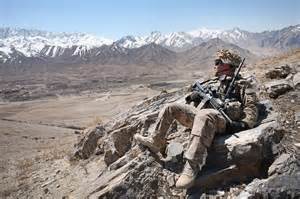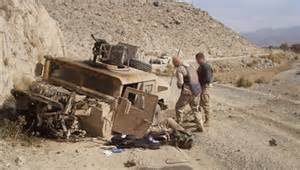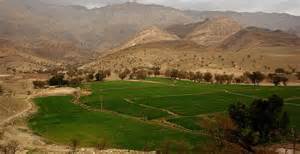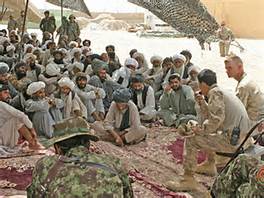Afghanistan is an example of how warfare can be detrimental to social and economic development. When the United Sates armed the mujahedeen fighting against Soviets during the 1980s, the Soviets were eventually forced out of  Afghanistan. Although successful, the anti-Soviet operation helped lay the ground work for the emergence of new menaces, al-Qaeda and the Taliban. After a period of civil conflict, the Taliban came to power in 1996. Al-Qaeda found a home, it was headquartered in Afghanistan when it launched the attacks of September 11, 2001.
Afghanistan. Although successful, the anti-Soviet operation helped lay the ground work for the emergence of new menaces, al-Qaeda and the Taliban. After a period of civil conflict, the Taliban came to power in 1996. Al-Qaeda found a home, it was headquartered in Afghanistan when it launched the attacks of September 11, 2001.
The U.S. and its coalition partners have been involved in Afghanistan since they drove the Taliban from power in late 2001. After 15 years of aid, Afghanistan’s living standards remain among the lowest in the world. The country is riddled by corruption, suffers from a dismal lack of infrastructure and housing. Clean water and electricity are in short supply. The current government headed by President Ashraf Ghani is struggling to run a country in which attacks by the Taliban are commonplace. The Taliban remains able to field a force estimated at between 45,000 and 65,000.
Slightly smaller than Texas, landlocked Afghanistan has a population of 32.5 million with a life expectancy of 50.8 years. The population is about 38 percent literate, 52 percent for males and 24 percent for females. The GDP of Afghanistan is $62.7 billion, a sad $2,000 per capita. Less than six percent of the population has access to the internet. Afghanistan is the world’s largest producer of opium. The Taliban is making money from the opium that supplies the European and Asian drug markets.
literate, 52 percent for males and 24 percent for females. The GDP of Afghanistan is $62.7 billion, a sad $2,000 per capita. Less than six percent of the population has access to the internet. Afghanistan is the world’s largest producer of opium. The Taliban is making money from the opium that supplies the European and Asian drug markets.
Afghanistan’s national unity government is unstable, anxious for continued foreign help. As it confronts the end of the international effort that fostered a mini-boom, the unemployment rate has climbed to 35 percent, about four times higher than in 2013. The jobless rate may be closer to 50 percent if the underemployed are included in the total. The unemployment problem was made worse by the 82,000 Afghans expelled from Pakistan and Iran’s deporting of approximately 150,000 Afghan workers.
Despite the over $35 billion that the U.S. has invested since 2001, the Afghan army and police (totaling 320,000) are rated as marginally effective. It is a  reflection of the dysfunction and corruption plaguing the Afghan forces. The 11,500 strong Afghan commando and Special Forces units are the exception, they are highly rated and overused in fighting the Taliban. With about 9,800 troops in the in the country, the U.S. continues to provide training and financial support to the Afghan military although it is said to be having difficulty overseeing how the money is spent.
reflection of the dysfunction and corruption plaguing the Afghan forces. The 11,500 strong Afghan commando and Special Forces units are the exception, they are highly rated and overused in fighting the Taliban. With about 9,800 troops in the in the country, the U.S. continues to provide training and financial support to the Afghan military although it is said to be having difficulty overseeing how the money is spent.
Afghanistan is over 99 percent Muslim, about 85 percent Sunni and 10-15 percent Shia. Foreign donors have invested more than $1 billion in training judges, prosecutors, establishing courts and helping draft a modern legal code. Conflicts arise from the potent mix of tradition, Islamic and civil law. Under Islamic law, men are allowed to have up to four wives. Around 15 percent of Afghan girls are married before the age of 15, a violation of the civil law saying that girls younger than 16 cannot marry.
The horrific Islamic State (ISIS) appeared in Afghanistan in January 2015. It is considered a serious threat by the Afghan government and the U.S.-led coalition. The number of ISIS fighters in the country is estimated at 1,000 to 3,000 with non-Afghans making up the majority. Some of the leaders are former Taliban, people who were kicked out as a result of leadership disputes. Last January, an ISIS group attacked the Pakistani consulate in Jalalabad killing several members of the Afghan security forces. An ISIS suicide bomber was responsible for the death of an anti-ISIS Afghan tribal leader and several other people.
While members of the Taliban are a bit more flexible in interpreting Islamic law, ISIS follows a literalist, strict and puritanical interpretation of Islam. Unlike the hallucination put forth by ISIS, members of the Taliban have little interest in global jihad. The evolving threat of ISIS may push the Afghan government and the Taliban into serious talks about ending the fighting. At this time, the peace discussions are undermined by continued Taliban attacks, Taliban internal wrangling and the weakness of the Afghan government. Until the matter is resolved, Afghanistan will remain a haven for terrorist networks.
hallucination put forth by ISIS, members of the Taliban have little interest in global jihad. The evolving threat of ISIS may push the Afghan government and the Taliban into serious talks about ending the fighting. At this time, the peace discussions are undermined by continued Taliban attacks, Taliban internal wrangling and the weakness of the Afghan government. Until the matter is resolved, Afghanistan will remain a haven for terrorist networks.
Many Afghans are losing faith in the government because of the increasing economic hardship, institutionalized corruption and deteriorating security conditions. If the international forces leave the country before a peace deal is reached between the Afghan government and the Taliban, it will leave a vacuum ISIS can exploit. As it has demonstrated, ISIS knows how to use conflict and chaos to expand its reach and attract recruits.
conditions. If the international forces leave the country before a peace deal is reached between the Afghan government and the Taliban, it will leave a vacuum ISIS can exploit. As it has demonstrated, ISIS knows how to use conflict and chaos to expand its reach and attract recruits.
In the untidy sphere of world affairs, Pakistan, China and Russia have an interest in seeing ISIS stopped in Afghanistan. If unchecked, ISIS will create more problems in Pakistan’s tribal regions, Russia’s borderlands and with the Uighurs in China. Iran is also aware of potential problems. Iranian security reports indicate that ISIS is aiming to attract supporters in Iran’s Kurdish region and in provinces containing a sizable Sunni minority.
problems in Pakistan’s tribal regions, Russia’s borderlands and with the Uighurs in China. Iran is also aware of potential problems. Iranian security reports indicate that ISIS is aiming to attract supporters in Iran’s Kurdish region and in provinces containing a sizable Sunni minority.
It is possible that the situation might be different today if the Western nations had not ignored Afghanistan during the 1990s. The many years of the venture in Afghanistan have confirmed that insurgent suppression and nation rebuilding are time consuming, difficult and costly undertakings. It turned out to be infinitely harder than the American government and its coalition partners anticipated in 2001. Over 2,300 American service members have been killed, approximately 20,000 wounded, made ill or injured. Over 1,000 civilian contractors have died and thousands of Afghan civilian lives have been snuffed out as the fighting drags on.
Afghanistan have confirmed that insurgent suppression and nation rebuilding are time consuming, difficult and costly undertakings. It turned out to be infinitely harder than the American government and its coalition partners anticipated in 2001. Over 2,300 American service members have been killed, approximately 20,000 wounded, made ill or injured. Over 1,000 civilian contractors have died and thousands of Afghan civilian lives have been snuffed out as the fighting drags on.
Discover more from Blog for Arizona
Subscribe to get the latest posts sent to your email.

he’s all gone their still there. born in the usa. the boss.